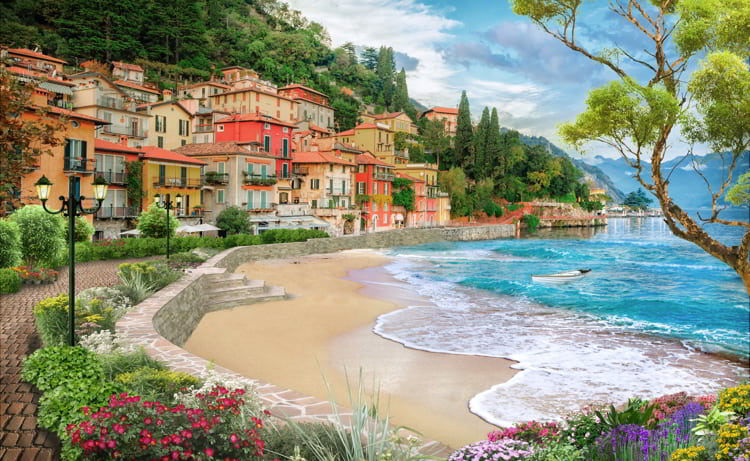Safe, Small, And Low Cost: Welcome To Kotor Bay, Montenegro
Kotor Bay is a deep, craggy inlet of the Adriatic Sea found in Montenegro.
It boasts 57 miles (107 kilometers) of sparkling coastline backed by towering mountains and dotted with a charming mix of medieval towns and luxe modern developments.
Most people haven’t heard of Montenegro, and that’s OK. It’s a tiny country of about 5,300 square miles (13,800 square-kilometers), making it about the size of Connecticut. It’s also tiny in terms of population, with about 620,000 people making their home here.
Montenegro is in Eastern Europe, sandwiched between Serbia, Bosnia and Herzegovina, Kosovo, Albania, and Croatia. Kotor Bay is in the southwest of the country.
It has a unique geography, full of nooks and crannies that together make up one of the most indented areas of the Adriatic Sea. Gorgeous views of the sea and mountains are a given regardless of where you are in the bay.
Kotor Bay is made up of three main towns: Kotor, Tivat, and Hercig Novi. Kotor is in the southeastern corner of the bay. The jewel in its crown is Kotor Old Town, a three-sided walled city of great historical significance that’s widely regarded as the best-preserved medieval town in the Mediterranean.
There are great reasons to live here: it has a mild climate—year-round, temperatures average between 36°F (2°C) and 88°F (31°C), a low cost of living, access to nature, diverse recreation opportunities, stunning scenery, and places to sit back and enjoy yourself (outdoor cafés overlooking the sea, rooftop bars, and so on).
Montenegro’s government values foreign investment and wants to attract more foreign residents. It makes it easy for expats to set up life here with its turn-key residency policies.
It continues to invest in tourism and construction… more hotel chains are establishing themselves here… cruise ships sail up to Kotor’s harbor on the daily… It’s only a matter of time before word about Montenegro spreads as far as North America, and Canadian and American tourists and expats start to arrive.
The biggest objective on Montenegro’s agenda right now is joining the European Union, which it’s poised to do in the next couple of years (some say by 2025; some say by 2030). It became an EU candidate in 2010 and adopted the euro as its currency in 2002.
Considering all that’s on offer, and unlike comparable destinations like Croatia, the cost of living in Montenegro is low. A couple can live comfortably here on a budget of 1,500 to 2,000 euros per month.
Prices vary from town to town, with Kotor Old Town and Tivat’s seafront drag costing the most compared to the villages scattered around the bay. You can rent a small, one- or two-bed apartment in Kotor Old Town for about 800 euros per month.
Every real estate agent I met with told me that property prices are on the rise… but I’m willing to bet that most American and Canadian retirees would consider Kotor Bay property a steal, especially considering the proximity to the sea and deep historical significance.
You can buy a modest, two-bedroom home, albeit one likely in need of some TLC, for as little as 50,000 euros. Inland, this price can go even lower.
Other expenses, like utilities, are low, too… One expat quoted me 40 euros per month for electric and water… He pointed out that if you’re moving to an older property, make sure that the meters were read recently so that you’re not stuck with the previous tenant’s unpaid bill.
If you’re taking taxis to get around, expect to spend 18 to 20 euros on the journey between Kotor Old Town and Tivat. The most I spent on transportation was 60 euros, which was the amount I paid to go from Kotor Old Town to Podgorica Airport—an hour-and-a-half drive.
In terms of food and drink, for a meal for two at a nicer place, expect to spend 50 to 60 euros, including drinks, mains, and dessert. You can have hearty meals at local spots for much less than this; 20 to 40 euros for two. For the average breakfast, you’ll pay 10 euros or less.
A cappuccino costs about 1.50 euros; a mini bottle of wine is 4.50 euros; a slice of pizza is 3 euros; a slice of cake is less than 5 euros.
In short, Kotor Bay offers some of the best value for money on the Continent.
Public buses and taxis operate in Kotor Bay. Taxis are plentiful and easy to find, with taxi ranks in popular areas (like outside Kotor Old Town and just off Tivat’s boardwalk). Drivers speak English, and rates are reasonable; most drivers use the meter to determine the fare.
You really need a car to have a comfortable, well-rounded lifestyle in Kotor Bay. I wouldn’t want to rely on public transportation if I lived here, and I wouldn’t want to limit myself to just my small section of the bay.
There’s tons to see in Montenegro. Many people who live on the coast have cabins in the small mountain towns, for instance. Or they head out on weekend ski trips, which involve driving a couple of hours… Your own car will facilitate all of that.
The roads are generally good quality, but Montenegro is extremely mountainous, which translates to hairy roads and a lot of driving through tunnels. All the more reason to have your own car—to put safety in your own hands when you’re traveling around the country.
I was surprised by how big, diverse, and active the expat community was in Kotor Bay. I had no trouble making connections. I found the best way to meet people was by joining expat Facebook groups.
The expat community in Kotor Bay is mostly made up of Europeans as well as some North Americans. Expats love this area for its safety, its access to nature, the myriad recreation opportunities, and the diverse and interesting community.
The downside is the lack of international-standard health care… although expats say for basic treatment, they’re happy with Montenegro’s care. Health care is free to Montenegro residents, but many expats prefer to keep a private insurance plan in place for access to private clinics and quicker treatment.
Montenegro is largely undiscovered by mainstream Western tourism. Those who find their way here enjoy the benefits of an undeveloped tourism market (and the resulting non-tourist prices).
You might think this relative isolation would add up to a low level of English… but I was surprised by the fluency of the locals. I had no trouble speaking to waiters, real estate agents, taxi drivers, shop attendants, and so on.
Americans and Canadians can come to Montenegro visa-free and stay for 90 days within a 180-day period. For longer stays, you’ll need to apply for a temporary residence permit.
Montenegro offers a unique residency program, whereby you can buy real estate worth any value and be granted temporary residency. This is the best way to get residency in Montenegro. Plus, it can be pretty affordable. Real estate here can cost as little as 50,000 euros.
Announce to friends and family, “I’m moving to Kotor Bay, Montenegro,” and you’ll probably get some funny looks.
Not many people have heard of Montenegro; to move here, you’ve got to be a little adventurous, a little bold, and a little open-minded to be able to come to terms with the realities of living in a country that’s still in development.
But you’ll be rewarded for that boldness…
You’ll be among the first to arrive to a place that I believe is going to explode in popularity over coming years.
You’ll get to enjoy stunning sea and mountain vistas every day… You’ll lower your current cost of living…
You’ll enjoy mild temperatures year-round as well as access to untouched nature…
You’ll be able to choose the lifestyle that suits you best among a diverse array of opportunities…
You’ll have a friendly expat community to lean on if culture shock becomes overwhelming at any point…
And you’ll be making a smart move, as property and rent are still cheap and it gets you residency and potentially a backdoor to the EU…








